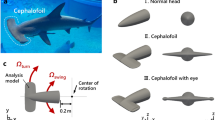Summary
Leeches swim by undulating their extended and flattened body in the dorsoventral direction, to form a wave that travels backwards along the animal. The troughs and crests of this body wave are produced by a metachronal rhythm of antiphasic contractions of the dorsal and ventral longitudinal musculature of the body wall of successive segments. Cinematographic records of swimming leeches show that over a range of cycle periods from 390 to 1100 msec the animal maintains one full wave along the length of its body. This constant wave form is achieved by compensating for the increase in the cycle period by an increase in the intersegmental travel time of the wave from 19 to 77 msec per segment. Direct muscle tension measurements of the segmental body wall during the swimming movement of a restrained, brainless and partially denervated leech lead to values for the dynamic parameters of the body wave which are in agreement with those abstracted from cinematographic records. In order to study the neuronal control of the swimming movement, a semi-intact leech preparation was developed. This preparation carries out movements that are clearly vestiges of the swimming rhythm while allowing the taking of electrophysiological records from exposed and immobilized parts of its peripheral and central nervous systems. The records reveal a nerve cell activity rhythm whose period matches that of the swimming rhythm. The swimming rhythm and its body wave must be generated by a system of distributed, phase-locked segmental oscillators that cause an antiphasic activity of the motor neurons innervating the segmental dorsal and ventral longitudinal muscles. The cycle of these oscillators can be inferred to consist of a variable time sector whose changes in length are responsible for changes in the cycle period, and of a constant time sector whose length is independent of the cycle period.
Similar content being viewed by others
References
Gray, Sir James: Animal locomotion. London: Weidenfeld & Nicolson 1968
Gray, J., Lissman, H. W., Pumphrey, R. J.: The mechanism of locomotion in the leech (Hirudo medicinalis Ray). J. exp. Biol.15, 408–430 (1938)
Kristan, W. B., Jr., Stent, G. S., Ort, C.A.: Neuronal control of swimming in the leech. III. Impulse patterns of the motor neurons. J. comp. Physiol.94, 155–176 (1974)
Mann, H.: Leeches (Hirudinea). New York: Pergamon Press 1962
Nicholls, J. G., Baylor, D. A.: Specific modalities and receptive fields of sensory neurons in the C.N.S. of the leech. J. Neurophysiol.31, 740–756 (1968)
Nicholls, J. G., Purves, D.: Monosynaptic chemical and electrical connections between sensory and motor cells in the central nervous system of the leech. J. Physiol. (Lond.)209, 647–667 (1970)
Nicholls, J. G., Purves, D.: A comparison of chemical and electrical synaptic transmission between single sensory cells and a motoneurone in the central nervous system of the leech. J. Physiol. (Lond.)225, 637–656 (1972)
Ort, C.A., Kristan, W. B., Jr., Stent, G. S.: Neuronal control of swimming in the leech. II. Identification and connections of the motor neurons. J. comp. Physiol.94, 121–154 (1974)
Schlüter, E.: Die Bedeutung des Zentralnervensystems vonHirudo medicinalis für Lokomotion und Raumorientierung. Z. wiss. Zool.143, 538–593 (1933)
Stein, P. S.: Intersegmental coordination of swimmeret motoneuron activity in the crayfish. J. Neurophysiol.34, 310–318 (1971)
Stuart, A. E.: Physiological and morphological properties of motoneurones in the central nervous system of the leech. J. Physiol. (Lond.)209, 627–646 (1970)
Uexküll, J. V.: Studien über den Tonus. III. Die Blutegel. Z. Biol.46 (N.F.28), 372–402 (1905)
Wever, R.: Pendulum versus relaxation oscillation. In: Circadian clocks (J. Aschoff, ed.), p. 74–83. Amsterdam: North Holland 1965
Author information
Authors and Affiliations
Additional information
We are indebted to Donald Kennedy and John G. Nicholls for valuable advice and suggestions throughout the course of this study and for vigorous criticisms of drafts of the manuscripts. We thank Margery Hoogs and Elizabeth Mullenbach for excellent technical assistance, and Ellis N. Story, Jr., for graphic and photographic work. This research was supported by Grant No. GB31933X from the National Science Foundation, and Public Health Service Research Grant No. GM 17866 and Training Grant No. GM 01389 from the Institute for General Medical Sciences.
Rights and permissions
About this article
Cite this article
Kristan, W.B., Stent, G.S. & Ort, C.A. Neuronal control of swimming in the medicinal leech. J. Comp. Physiol. 94, 97–119 (1974). https://doi.org/10.1007/BF00617837
Received:
Issue Date:
DOI: https://doi.org/10.1007/BF00617837




